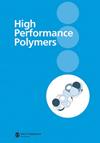利用干喷湿纺技术制造高性能聚酰亚胺纤维
IF 1.6
4区 化学
Q3 POLYMER SCIENCE
引用次数: 0
摘要
通过湿法纺丝和干法喷气湿法纺丝,分别制备了由3,3,4,4'-联苯二酐(BPDA)、对苯二胺(p-PDA)和2-(4-氨基苯基)-5-氨基苯并咪唑(BIA)衍生的高性能共聚酰亚胺(co-PI)纤维。系统研究了湿法纺丝和干法喷气湿法纺丝工艺对共PI纤维结构和性能的影响。与湿法纺丝相比,干喷湿法纺丝制备的共 PI 纤维表面形态更光滑,机械性能更高。广角 X 射线衍射(WAXD)结果表明,干喷湿纺制备的共 PI 纤维沿纤维方向呈现出高度取向结构,横向上的横向堆积有序度较低。小角 X 射线散射(SAXS)显示,干喷湿法纺丝制备的共 PI 纤维中微空洞的半径、长度、错向度和内表面粗糙度均低于湿法纺丝制备的共 PI 纤维。此外,还研究了干喷湿纺过程中空气层高度以及热处理对纤维结构和性能的影响。在空气层高度为 10 毫米、热拉伸温度为 440°C 的条件下,干喷湿纺制备的共 PI 纤维的拉伸强度和模量分别达到了 2.72 GPa 和 114.29 GPa。本文章由计算机程序翻译,如有差异,请以英文原文为准。
Fabrication of high performance polyimide fibers by dry-jet wet spinning technology
High-performance co-polyimide (co-PI) fibers derived from 3,3`4,4`-biphenyldianhydride (BPDA), p-phenylenediamine (p-PDA) and 2-(4-aminophenyl)-5-amino-benzimidazole (BIA) were prepared via the wet spinning and dry-jet wet spinning method, respectively. The distinctions between wet spinning and dry-jet wet spinning processes on the structures and properties of co-PI fibers were systematically investigated. The co-PI fibers prepared by dry-jet wet spinning exhibited smoother surface morphology and higher mechanical properties than those of co-PI prepared by wet spinning. Wide-angle X-ray diffraction (WAXD) results showed that the co-PI fibers prepared by dry-jet wet spinning exhibited highly oriented structure along the fiber direction along with a low degree of lateral packing order in the transverse direction. Small-angle X-ray scattering (SAXS) revealed that the radius, length, misorientation and internal surface roughness of the microvoids in the co-PI fibers prepared by the dry-jet wet spinning are lower than those in co-PI fibers prepared by wet spinning. Moreover, the effect of air layer height, as well as the heat treatment on the structure and properties of fibers during the dry-jet wet spinning process, was also studied. The tensile strength and modulus of co-PI fibers prepared by dry-jet wet spinning reached 2.72 GPa and 114.29 GPa, respectively, with an air layer height of 10 mm and a heat stretching temperature of 440°C.
求助全文
通过发布文献求助,成功后即可免费获取论文全文。
去求助
来源期刊

High Performance Polymers
化学-高分子科学
CiteScore
4.20
自引率
14.30%
发文量
106
审稿时长
1.2 months
期刊介绍:
Health Services Management Research (HSMR) is an authoritative international peer-reviewed journal which publishes theoretically and empirically rigorous research on questions of enduring interest to health-care organizations and systems throughout the world. Examining the real issues confronting health services management, it provides an independent view and cutting edge evidence-based research to guide policy-making and management decision-making. HSMR aims to be a forum serving an international community of academics and researchers on the one hand and healthcare managers, executives, policymakers and clinicians and all health professionals on the other. HSMR wants to make a substantial contribution to both research and managerial practice, with particular emphasis placed on publishing studies which offer actionable findings and on promoting knowledge mobilisation toward theoretical advances. All papers are expected to be of interest and relevance to an international audience. HSMR aims at enhance communication between academics and practitioners concerned with developing, implementing, and analysing health management issues, reforms and innovations primarily in European health systems and in all countries with developed health systems. Papers can report research undertaken in a single country, but they need to locate and explain their findings in an international context, and in international literature.
 求助内容:
求助内容: 应助结果提醒方式:
应助结果提醒方式:


